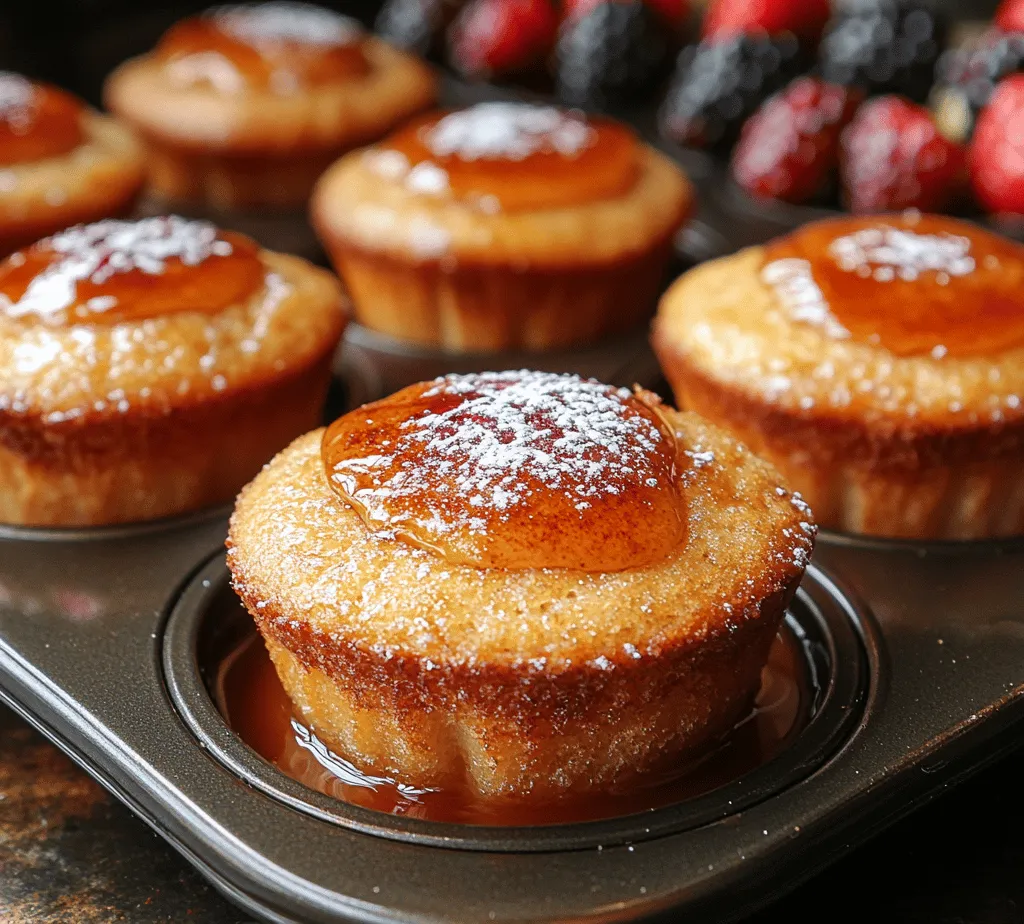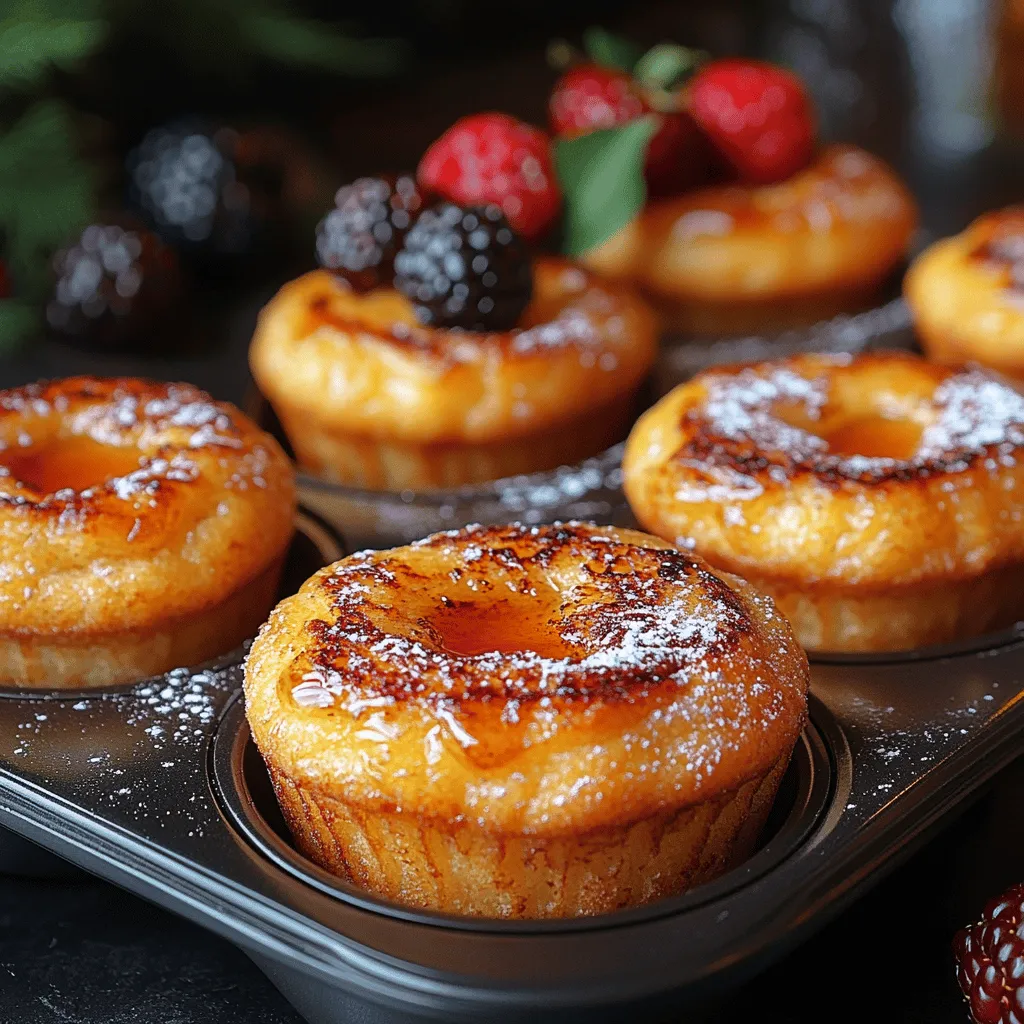Introduction
French toast is a beloved breakfast classic that has graced tables for generations. Its irresistible combination of crispy edges and a soft, custardy center makes it a favorite for family gatherings, brunches, and cozy weekends at home. Traditionally made by soaking slices of bread in an egg and milk mixture before frying them to golden perfection, French toast has inspired countless variations and adaptations. One such delightful twist on this classic recipe is the Fluffy French Toast Muffins, a fun and innovative take that transforms the beloved breakfast into an easy-to-make muffin format.
These Fluffy French Toast Muffins are perfect for busy mornings or lazy weekends when you want to indulge in a comforting breakfast without the fuss. They’re not only quick to prepare but also versatile enough to suit any occasion, whether it’s a holiday brunch, a weekday breakfast, or even a sweet treat for a cozy afternoon snack. The muffins can be made ahead of time, stored, and reheated, making them an ideal choice for meal prep enthusiasts and busy families alike.
In this article, we’ll dive into the wonderful world of Fluffy French Toast Muffins, exploring their unique flavors and textures while guiding you through the preparation process. You’ll learn about the key ingredients that make this recipe shine and how to achieve that perfect fluffy consistency in every bite.
Understanding the Ingredients
To create the perfect Fluffy French Toast Muffins, it’s essential to understand the roles of each ingredient in the recipe. The right combination of components not only contributes to the flavor and texture but also elevates this dish to a new level of deliciousness.
Day-Old Bread
One of the most crucial ingredients for Fluffy French Toast Muffins is bread, and specifically, using day-old bread. Fresh bread can become overly soggy when soaked in the custard mixture, leading to a less-than-ideal texture. Day-old bread, on the other hand, has had time to stale and dry out slightly, making it perfect for absorbing the egg and milk mixture without disintegrating.
Opt for bread varieties that are rich and flavorful, such as brioche, challah, or even sourdough. Each type brings its unique taste and texture to the muffins, enhancing the overall experience. Brioche offers a buttery richness, challah brings a slightly sweet flavor, and sourdough adds a tangy note that can beautifully contrast the sweetness of the muffins.
Eggs
Eggs play a pivotal role in this recipe, serving as the binding agent and providing the custard-like consistency that is characteristic of traditional French toast. When whisked with milk, eggs create a creamy mixture that envelops the bread cubes, ensuring that every piece is infused with flavor.
In addition to texture, eggs also contribute to the muffins’ overall structure. As they bake, the proteins in the eggs firm up, helping the muffins retain their shape while still remaining fluffy and tender.
Milk
Milk is another essential ingredient in the custard mixture, providing moisture and creaminess. While traditional recipes often call for whole milk, you can easily customize this muffin recipe to suit your dietary preferences. Non-dairy alternatives, such as almond, soy, or oat milk, work wonderfully in this recipe, allowing everyone to enjoy the deliciousness of Fluffy French Toast Muffins without compromising on flavor.
The type of milk you choose can subtly influence the taste of the muffins. For instance, whole milk will yield a richer, creamier muffin, while lighter alternatives may produce a slightly less decadent version.
Sugar and Vanilla Extract
Sugar and vanilla extract are key players in enhancing the sweetness and aroma of the muffins. Granulated sugar adds a gentle sweetness, balancing the savory notes of the eggs and bread. Vanilla extract, on the other hand, infuses the muffins with a warm and inviting aroma that is simply irresistible. Together, these ingredients create a delightful flavor profile that will have your taste buds dancing with joy.
Ground Cinnamon
Cinnamon is the spice that takes these muffins to the next level. Its warm and aromatic qualities add depth and complexity to the flavor, perfectly complementing the sweetness of the sugar and the richness of the bread. A sprinkle of ground cinnamon can transform a simple muffin into a comforting treat that evokes memories of cozy breakfasts and family gatherings.
Salt
Though often overlooked, salt plays a crucial role in balancing the sweetness of this recipe. A pinch of salt enhances the overall flavor, bringing out the best in the other ingredients. It’s essential to include this small but mighty component to ensure your Fluffy French Toast Muffins are well-rounded and delicious.
Optional Toppings
To further elevate your Fluffy French Toast Muffins, consider adding optional toppings that can enhance both the presentation and taste. Popular choices include maple syrup, powdered sugar, fresh fruit, or a dollop of whipped cream. These extras not only add visual appeal but also allow you to customize the muffins to suit your preferences and occasion.
Step-by-Step Preparation Guide
Now that we’ve explored the key ingredients, it’s time to roll up our sleeves and get started on making these delightful Fluffy French Toast Muffins. Follow this step-by-step guide to ensure your muffins turn out perfectly every time.
Preheating the Oven
The first step in preparing your Fluffy French Toast Muffins is to preheat your oven. Set it to 350°F (175°C) and allow it to fully heat up while you prepare the batter. Preheating the oven is crucial for achieving that perfect rise and fluffy texture, so don’t skip this step.
Greasing the Muffin Tin
Once your oven is preheated, it’s time to prepare your muffin tin. Generously grease each muffin cup with cooking spray or butter to prevent sticking. Alternatively, you can use paper liners for easy removal and cleanup. Ensuring that the muffin tin is adequately greased will help maintain the shape of the muffins as they bake and make for a hassle-free serving experience.
Preparing the Bread
Next, prepare your bread by cutting it into cubes. Aim for uniform pieces, approximately 1-inch in size, so that they cook evenly. Using a serrated knife can make this task easier, especially if you’re working with crusty bread.
As you cut the bread, consider the type of bread you’re using. Brioche and challah will create a softer, more tender muffin, while sourdough will provide a delightful chewiness and tangy flavor. Whichever type you choose, day-old bread is highly recommended for optimal texture and flavor absorption.
Making the Custard Mixture
With your bread cubes ready, it’s time to create the custard mixture. In a mixing bowl, whisk together the eggs and milk until thoroughly combined. This process is crucial for achieving a smooth and creamy custard that will coat the bread evenly.
Once the eggs and milk are well blended, add in the sugar, vanilla extract, ground cinnamon, and a pinch of salt. Continue whisking until the mixture is smooth and all ingredients are fully incorporated. The goal is to create a homogeneous custard that will lend its rich flavor to the bread cubes.
Once your custard mixture is ready, you can proceed to combine it with the prepared bread cubes, ensuring that each piece is well-coated in the custard for maximum flavor.
In the next part of this article, we will guide you through the final steps of combining the ingredients, filling the muffin tin, and baking your Fluffy French Toast Muffins to perfection. Stay tuned for delicious tips on achieving the best results and making the most out of this delightful recipe!

Tips for Incorporating Sugar, Vanilla, Cinnamon, and Salt
When crafting your Fluffy French Toast Muffins, the combination of sugar, vanilla, cinnamon, and salt is essential for elevating the flavors. Start with granulated sugar for sweetness, which not only enhances the taste but also contributes to the muffins’ golden-brown color during baking. If you’re looking for a more complex sweetness, consider using brown sugar, which adds a rich, caramel-like depth.
Vanilla extract plays a pivotal role in infusing a warm, aromatic flavor into the custard mixture. Opt for pure vanilla extract for the best results, as imitation vanilla may lack the depth of flavor. A teaspoon or two should suffice, but feel free to adjust according to your preference.
Cinnamon is the spice that ties everything together, providing warmth and a hint of nostalgia reminiscent of traditional French toast. A teaspoon is usually perfect, but if you’re a cinnamon enthusiast, you might want to increase it slightly.
Salt, often overlooked, balances the sweetness and enhances the overall flavor profile. A pinch of salt is all you need; it works wonders in bringing out the sweetness and making the muffins taste more rounded.
Combining Bread and Custard
The heart of this recipe lies in the custard mixture, which you will combine with cubed bread. Begin by cutting your bread into small cubes, ideally about 1-inch in size. This allows for an even soak, ensuring that each piece absorbs the custard mixture thoroughly.
In a large bowl, whisk together your eggs, milk, sugar, vanilla, cinnamon, and salt until well combined. This custard base will deeply flavor the muffins, so it’s crucial to mix it until there are no streaks of egg remaining. Once your custard is ready, it’s time to fold in the bread cubes.
Techniques for Folding Bread into the Custard Mixture
Folding the bread into the custard mixture requires a gentle touch. Use a spatula or wooden spoon to lift the bread cubes from the bottom of the bowl, allowing the custard to coat each piece. Be careful not to mash the bread; you want to maintain its integrity while ensuring that every cube is soaked.
Once the bread is well-coated, let it sit for a few minutes. This resting time allows the bread to absorb the custard, creating a rich and flavorful base for your muffins.
Importance of Soaking Time for Flavor Absorption
Soaking time is crucial for flavor absorption. Ideally, let the bread soak in the custard mixture for at least 15-20 minutes, or longer if time permits. If you have the luxury of time, consider soaking the mixture in the refrigerator for up to an hour, or even overnight. This extended soaking will yield muffins that are bursting with flavor and incredibly moist.
Filling the Muffin Tin
Once your bread is adequately soaked, it’s time to fill the muffin tin. Preheat your oven to 350°F (175°C) as you prepare your muffin tin. Greasing the muffin cups with cooking spray or butter ensures easy removal and prevents sticking.
Best Practices for Portioning the Mixture into Muffin Cups
Using a ladle or measuring cup, portion the soaked bread mixture into the muffin cups. Fill each cup about three-quarters full, allowing room for the muffins to rise during baking. This will help ensure that your muffins achieve the perfect fluffy texture without spilling over.
Visual Cues for Knowing When to Stop Filling
A good visual cue is to aim for a slight domed shape above the rim of the muffin cup. The batter should not overflow, as this can create a mess in your oven. If you notice any bread pieces sticking out, gently press them down to ensure even baking.
Baking the Muffins
With your muffin tin filled, it’s time to bake! Place the muffin tin in your preheated oven and set a timer for 18-22 minutes. The muffins will rise beautifully, and you’ll begin to notice a delightful aroma wafting through your kitchen.
Baking Times and Temperature Guidelines
Monitor the muffins closely as they bake. Ovens can vary, so while the general guideline is 18-22 minutes, you may want to check for doneness around the 18-minute mark. The tops should be golden brown and slightly firm to the touch.
How to Check for Doneness
To ensure your muffins are fully baked, perform a toothpick test. Insert a toothpick into the center of one muffin; it should come out clean or with a few moist crumbs attached. If there’s wet batter on the toothpick, give the muffins a few more minutes in the oven.
Cooling and Serving
After removing the muffins from the oven, allow them to cool in the pan for about 5-10 minutes. This cooling period is essential; it helps the muffins set and makes them easier to remove without falling apart.
Importance of Cooling Time for Texture
Cooling also improves the texture, ensuring that the muffins are fluffy rather than dense. If you try to remove them too soon, the muffins may stick to the pan or break apart.
Tips for Safely Removing Muffins from the Tin
To safely remove the muffins, gently run a butter knife around the edges of each muffin cup. This will loosen any areas that may have stuck. Carefully lift each muffin out, placing them on a wire rack to cool completely. If you don’t have a wire rack, a plate will suffice, but a wire rack allows air to circulate around the muffins, preventing sogginess.
Exploring Serving Suggestions
Once your Fluffy French Toast Muffins have cooled, it’s time to serve! Drizzling with maple syrup is a classic choice that adds a touch of sweetness and enhances the overall flavor. The syrup complements the cinnamon and vanilla beautifully, making for a comforting breakfast treat.
Using Optional Toppings for an Elevated Experience
Consider adding optional toppings such as powdered sugar for a touch of elegance, or fresh berries for a burst of color and freshness. Whipped cream can also elevate the experience, creating a decadent treat that feels indulgent.
Suggestions for Pairing with Beverages
Pair your muffins with a warm beverage for the ultimate breakfast or brunch experience. Coffee, tea, or even a glass of fresh orange juice can complement the flavors beautifully. A spiced chai or a latte would pair particularly well, enhancing the cozy vibe of your meal.
Nutrition and Dietary Considerations
These Fluffy French Toast Muffins can be a delightful addition to your breakfast table, but it’s essential to consider their nutritional content. Each muffin typically contains a balanced mix of carbohydrates, protein, and fat, making them a satisfying option to start your day.
Overview of Nutritional Content per Serving
Roughly, each muffin contains about 150-200 calories, depending on the specific ingredients used. They offer a good source of energy and can be enjoyed as part of a balanced breakfast.
Potential Modifications for Dietary Restrictions
If you have dietary restrictions, you can easily modify this recipe. For a gluten-free version, substitute regular bread with gluten-free bread. For a vegan alternative, replace the eggs with flaxseed meal and use a plant-based milk like almond or oat milk.
How to Store Leftovers and Reheat for Future Enjoyment
If you have leftovers, store the muffins in an airtight container at room temperature for up to three days. For longer storage, consider freezing them. Simply place the cooled muffins in a freezer-safe bag and enjoy them within three months. To reheat, pop them in the microwave for 20-30 seconds or warm them in a toaster oven for a few minutes until heated through.
Conclusion
Making Fluffy French Toast Muffins is a delightful experience that yields a treat everyone will love. With their fluffy texture, rich flavor, and endless serving possibilities, these muffins can easily become a staple for breakfast or brunch gatherings. Whether you’re enjoying them on a quiet Sunday morning or serving them at a festive brunch, these muffins are sure to impress.
Don’t hesitate to try this recipe; it’s not just easy to make but also a fantastic way to enjoy the comforting taste of French toast in muffin form. Your friends and family will thank you for this delicious homemade treat!

